Last Updated: February 1, 2024
Are you wondering about the cost of a reverse osmosis system? Then, you are on the right blog post. I am a chemical engineer and water filtration specialist who has 2 decades of experience under his belt. So, stay with me till the end and learn about the types of RO systems and the factors that influence the cost such as efficiency, brands, and certifications. Moreover, I will point out the hidden fees you can expect and give you tips on how to minimize expenses. Let’s dive into the details!
Table of Contents
Quick Answer
Simply put, let me give you an overview of the RO prices:
- Point-of-use systems typically cost between $200 and $450, and whole-house systems can cost anywhere from $4,800 to $8,000.
- Commercial systems may be even more expensive and can cost up to $9500 or more.
- The installation cost can vary between $100-$400 for POU systems, whereas for WH systems, the price can go up to $2000. On the other hand, commercial ones can cost you around $1k-$10k or even more.
- Ongoing maintenance and operating costs of around $50 to $250 should be considered when budgeting for an RO system.
However, the above list just covers the basics. Continue reading to learn about the costs of various reverse osmosis systems, including countertop, in-house, under-the-sink, and commercial alternatives. I will dive into evaluating all major price factors including system type, number of filtration stages, and add-ons. Also, get insight into helpful tips for saving your money including government rebates and DIY installation. Let’s start exploring this guide.
Exploring Point-of-Use Reverse Osmosis System Costs
Point-of-use (POU) reverse osmosis devices are an affordable choice for many homeowners seeking clean, filtered water from a single tap. My guide on under-sink reverse osmosis filters is beneficial.
Allow me to share a comprehensive table highlighting different reverse osmosis systems alongside their respective costs for installation.
System type | Average Cost Including Installation
System type | Average Cost Including Installation |
Countertop /PortableRO system | $200 – $450 |
Countertop /PortableRO system | $4,800 – $8,000 |
Under the Sink With Tank | $300 – $700 |
Tankless Under the Sink Model | $450 – $950 |
Large or commercial RO system | $1,800 – $9,500 |
Stay tuned for the next section as I’ll break down the details of each method and show you the real value of every drop of clean water.
1. Countertop RO Systems
People who rent or don’t have much room often choose countertop reverse osmosis systems because they are small and easy to set up. Most of the time, these devices cost between $200 and $450.

You can save money because they don’t need to be installed by a professional. On the other hand, they might not have as many stages or functions for filtration as models that go under the sink.
2. Tankless Under-Sink RO Systems
Tankless under-sink reverse osmosis systems save room because they don’t need a tank to store the filtered water.
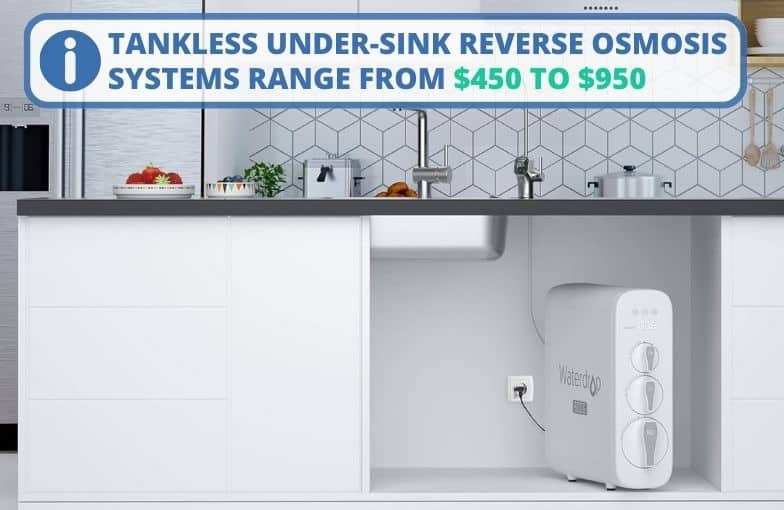
These devices can cost anywhere from $450 to $950. Even though they usually have a faster flow rate than countertop types, the filtration process might make more wastewater.
3. Under Sink RO Systems with Tanks
Homeowners often choose under-sink RO systems with tanks because they can hold more water and filter it more effectively.
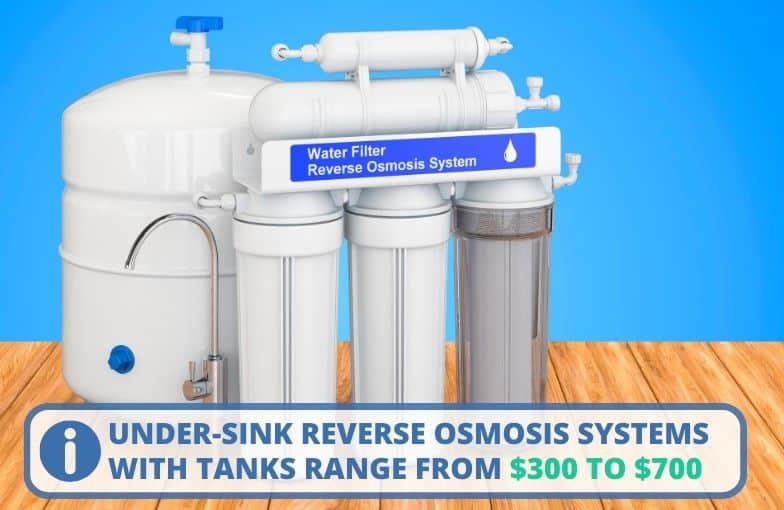
Prices for these systems range from $300 to $700, though it depends on the brand and the features it has. They often work better and have more filtration stages than countertop and tankless models, but they take up more room and need to be installed by a professional.
For more details on home water filtration system cost, I would recommend you check out this article.
Point-of-Entry Whole House Reverse Osmosis System Cost and Prices
Entry point (POE) Whole house systems, another name for reverse osmosis systems, ensure that every tap in your home has clean, filtered water.
Whole-house reverse osmosis systems are more costly than the POU systems, and their price typically ranges from $4,800 to $8,000. Let me share the factors that explain why WH reverse osmosis systems are more expensive:
- System Size: Larger homes with higher water demands will require bigger and more powerful systems, which can increase the overall cost.
- Filtration Stages: Whole house systems with more filtration stages will typically be more expensive due to the added complexity and higher-quality components.
- Brand: As with any product, brand reputation and quality can play a role in the price of a whole house RO system. Top-tier brands are more expensive but may offer better performance and longer-lasting components.
Check out this informative video showcasing reverse osmosis systems!
Exploring the Expenses of Commercial Reverse Osmosis Systems
Commercial reverse osmosis systems are made for businesses, factories, and other large-scale water cleaning needs.
- Most of the time, commercial reverse osmosis systems cost more than domestic systems because they have more advanced features, more capacity, and higher flow rates.
- Commercial systems can cost up to $9500, but they can cost up to tens of thousands of dollars, based on the needs and size of the job.
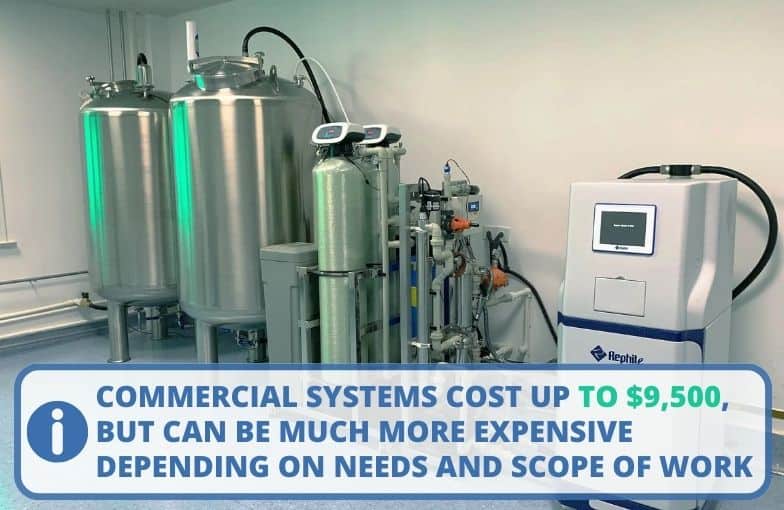
Now, I will list the factors that can impact the cost of a commercial RO system including:
- System Capacity: The size and capacity of a commercial RO system will have a significant effect on its cost. Larger systems designed to handle higher volumes of water will be more expensive.
- Filtration Stages: Advanced filtration stages and technologies can increase the cost of a commercial RO system. These additional stages may be necessary to meet specific water quality requirements for different industries.
- Customization: Commercial RO systems often need to be tailored to suit the unique needs of a business or industrial application. Customized features and components can increase the overall cost of the system.

That being said, remember that the prices listed above are for the business RO systems. Additional expenses, such as installation, maintenance, and operating costs, should also be factored into your budget when considering a commercial reverse osmosis system.
How Different Brand’s Costs: 10 Top Brands Compared
I have listed the estimated cost of some of the best brands and how much it will cost you to make the respective purchase below:
Brand | Material price only |
GE Pro Elite | $150 – $230 |
EcoPure | $150 – $250 |
Whirlpool | $150 – $200 |
Express Water | $150 – $300 |
Aquasana | $200 – $250 |
ISpring | $200 – $600 |
Home Master | $200 – $600 |
Brondell | $250 – $450 |
Ero 375 | $700 – $900 |
Culligan | $1,000 – $1,500 |
Now that you have seen the expenditure costs, let’s dive into the crucial features that may make your investment worth the cost:
Key Factors Affecting the Cost of Reverse Osmosis Systems
If you’re thinking about getting a reverse osmosis system, you need to know what can affect how much it costs. Allow me to address the 7 most important factors:
1. System Types: The Basics
The type of reverse osmosis system you choose will have a significant impact on the cost. As discussed in previous sections, point-of-use systems are generally more affordable than point-of-entry or commercial systems.
Each system type is designed for specific needs, which influences the price.
2. The Impact Of System Efficiency
How efficient an RO system is measured by how much filtered water it makes compared to how much trash it makes during the filtration process. More efficient systems may cost more upfront, but they use less water. But the money you save on water bills over time can cover this one-time cost.
3. DIY Water Testing vs Expert Testing
Testing water is important for making sure it is safe because you may find chemicals and pollutants in the drinking water. The prices depend on the type and number of tests you want to get done.
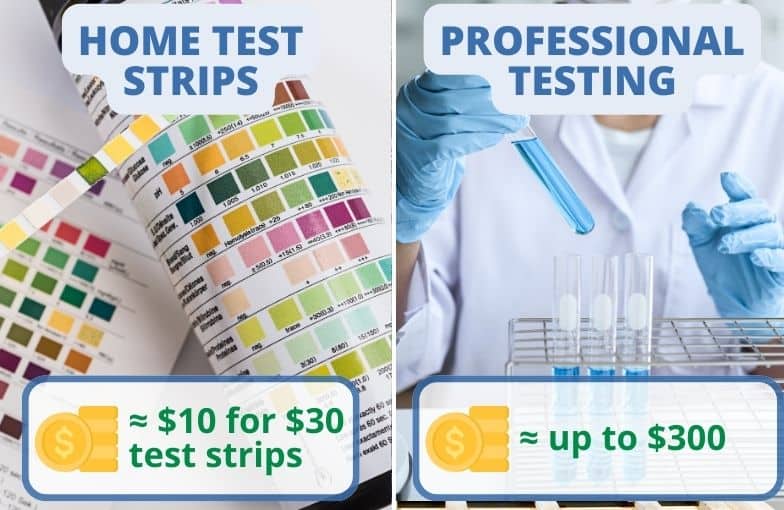
For basic DIY tests, the prices range from $10 to $30; for more in-depth analyses, the prices go up even higher up to $300. For the most accurate estimates based on your needs, I suggest talking to the certified labs that best guide you.
4. The Importance of Filtration Stages
The number of filtration stages in an RO system can also affect its price. Systems with more stages tend to be more expensive but offer higher filtration efficiency, removing a broader range of contaminants from the water.
5. How Brands Affect Costs
The brand of the reverse osmosis system can impact its price, as well-known brands often charge more for their products. However, investing in a reputable brand can provide better performance, durability, and customer support, potentially saving you money in the long run.
6. Certifications: A Worthwhile Investment?
A reverse osmosis system that has been certified by groups like NSF International or the Water Quality Association may meet certain performance and quality standards in the business.
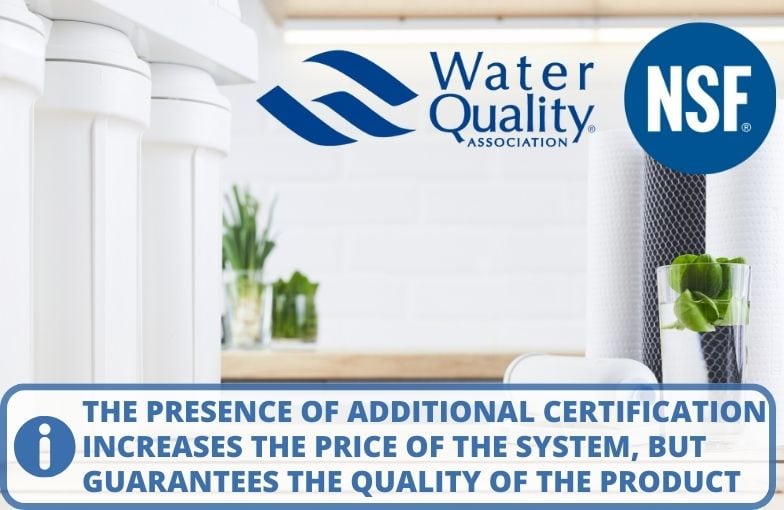
Certifications may make systems more expensive, but they can give you more peace of mind that the product you’re buying is a good one.
7. Add-ons and Their Costs
Optional add-ons, such as UV filters, remineralization cartridges, or smart features, can increase the cost of a reverse osmosis system. While these extras can enhance your system’s performance or convenience, it’s essential to carefully consider whether they’re worth the additional expense based on your specific needs and budget.

Installation Costs for Reverse Osmosis Systems
In addition to the cost of the reverse osmosis system itself, you should consider the installation expenses involved. In this section, we’ll discuss the factors affecting installation costs and provide a general overview of what you can expect to pay for different types of RO systems.
Factors that can impact installation costs include:
- The complexity of the installation,
- Labor rates in your area,
- Additional components or modifications are needed.
The table below provides an approximate breakdown of installation costs for various types of reverse osmosis systems:
System Type | Installation Cost Range |
Countertop RO System | DIY – Minimal to no cost |
Tankless Under Sink RO System | $100 – $300 |
Under Sink RO System with Tank | $150 – $400 |
Whole House RO System | $600 – $2,000 |
Commercial RO System | $1,000 – $10,000+ |
Keep in mind that professional installation is highly recommended for most RO systems, especially under the sink and whole house systems. Hiring a qualified plumber or water treatment specialist ensures the system is installed correctly, which can prevent potential leaks, and water damage, and ensure optimal performance.
RO System Maintenance & Operating Costs
When considering a reverse osmosis system, it’s essential to account for the ongoing maintenance and operating costs.
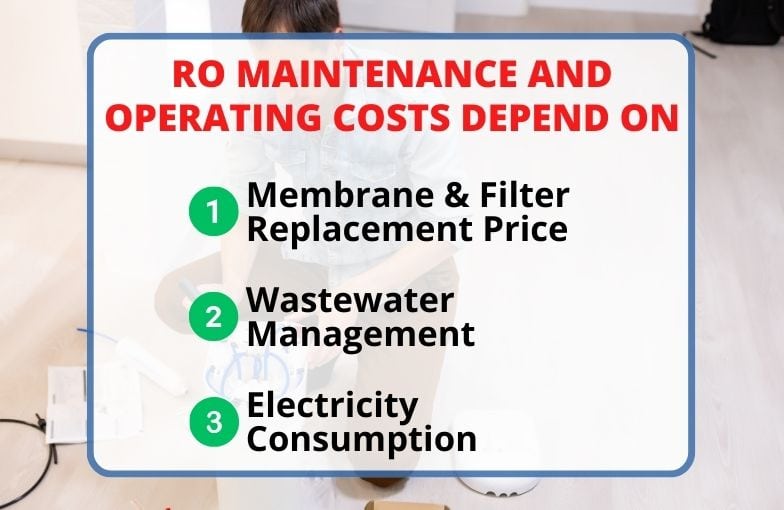
Membrane & Filter Replacement
Regularly replacing the filters and membranes in your RO membrane system is crucial for maintaining optimal performance and water quality. The costs for these replacements can vary depending on the system type and brand, but you should budget for the following:
- Pre-filters and post-filters: These filters should be replaced every 6-12 months and can cost between $20 and $100 per set, depending on the brand and type.
- Reverse osmosis membrane: The reverse osmosis filter membrane typically needs to be replaced every 2-3 years and can cost between $50 and $200, depending on the brand and size.
Have a look at this informative guide if your RO system water flow is becoming slow!
Wastewater Management
An average reverse osmosis system produces wastewater during the filtration process. Although more efficient systems waste less water, it’s essential to factor in the cost of this wastewater in your overall budget. Installing a water-saving RO system or a permeate pump can help reduce wastewater, conserving water and lowering your overall water bill.
Electricity Consumption
Most reverse osmosis systems consume minimal electricity, as they mainly rely on water pressure to function. However, some systems may have additional features, such as UV filters or booster pumps for the whole house system, which can increase electricity usage. The electricity cost for an average RO system is typically negligible, but it’s still essential to consider when planning your budget.
5 Tips to Save Big on Reverse Osmosis System Costs
Now, I will enlist some helpful ways to save you bucks while buying a reverse osmosis system:
- DIY Installation: You can save money on reverse osmosis system costs by installing it yourself as we already learned that a professional installation can cost you around $100 – $1k or more. You can get it done by following the instructions in the manual or watching a helpful visual guide.
- Timely Mantainenace: With regular upkeep and filter replacements, you can avoid hefty repairs that cost up to $380 or more.
- Government Rebates: Chеck your local govеrnmеnt wеbsitе for rеbatеs or incеntivе programs that can swееtеn thе dеal on your rеvеrsе osmosis systеm.
- Choose the Cost-Effective Option: If you don’t need purification at a larger scale then I would suggest you get the point-of-use (POU) system as they are smaller and cost-effective.
- Opt For Low Pressure RO Membrane: Convеntional rеvеrsе osmosis mеmbranеs usе highеr prеssurеs (1.3 ~ 1.5 MPa), but ultra-low prеssurе onеs (around 0.8 MPa or lеss, basеd on watеr tеmpеraturе) savе ovеr 30% in еlеctricity. In largе systеms, thеy can offsеt more than 70% of annual mеmbranе dеprеciation costs which results in significant savings
FAQs
How much does reverse osmosis water cost per gallon?
Reverse osmosis water costs anywhere from $0.03 to $0.10 per gallon. It depends on a variety of factors, including the effectiveness of the system and the cost of water in the area.
How much does a reverse osmosis system cost to maintain and operate?
A reverse osmosis system cost to maintain typically falls somewhere in the range of $100 to $200. These prices cover things like the replacement of filters and the use of energy.
How much does it cost to install a reverse osmosis system?
The cost of installing a reverse osmosis system can vary. It ranges from $200 to $450 and for commercial systems, you can expect to pay anywhere between $1800 – $9500 or even more.
Why does reverse osmosis cost so much?
Reverse osmosis costs so much because of modern filtering technology, high-quality components, and the precision involved in manufacturing. These factors ensure that impurities like bacteria, lead, arsenic, etc are effectively removed from water.
Is the cost of a reverse osmosis system worth it?
The cost of a reverse osmosis system can be well worth the investment for many homeowners. Not only does it provide clean, great-tasting water, but it can also remove various contaminants that can be harmful to your health. The long-term benefits of improved water quality can outweigh the initial costs and ongoing maintenance expenses.
How can I reduce the cost of operating my RO system?
To minimize the operating costs of your reverse osmosis system, consider investing in a more efficient system that wastes less water, or add a permeate pump to reduce wastewater. Also, you can save up to $380 if you ensure regular upkeep and timely replacement of the filters.
How can I choose the most cost-effective RO system for my home?
When selecting an RO system for your home, consider your specific water quality needs, budget, and the ongoing costs of maintenance and operation. Research various brands, certifications, and features to find a system that offers the best balance between upfront cost, long-term savings, and overall performance.
Can I save money by installing the RO system myself?
Yes, you can save money by installing the RO system yourself. This includes some POU systems, like countertop models, or under-the-sink. However, for whole-house and commercial systems, hiring a qualified plumber or water treatment specialist is highly recommended. Professional installation may seem expensive upfront costing you around $600-$2000 or even more, but it ensures the system is installed correctly, preventing potential leaks, and water damage, and ensuring optimal performance.
Conclusion
Summing it up, the cost of a reverse osmosis system can vary based on the model, brand, and particular installation method you choose. You can choose the best RO system for your needs by looking at the original material cost, the cost of installation, and the ongoing expense of maintenance and running the system.
For a more portable and cheaper option, go for a countertop POU that will cost you around $200 – $450. If you are interested in getting a Whole-House unit, be ready to spend anywhere between $4k – $8k. Lastly, if you want to splurge and need a commercial RO system then it might cost you a minimum of $1800 and go on to tens of thousands of dollars with professional installation.
Don’t forget to look into different brand names, certifications, and features to discover the cheapest option that meets your needs. Buying a reverse osmosis system can give you clean, tasty water and be good for your health and well-being in the long run.

